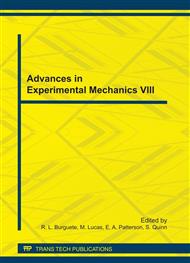p.183
p.189
p.195
p.201
p.207
p.213
p.219
p.225
p.231
Dynamic Behavior of Advanced Ti Alloy under Impact Loading: Experimental and Numerical Analysis
Abstract:
Industrial applications of Ti-based alloys, especially in aerospace, marine and offshore industries, have grown significantly over the years primarily due to their high strength, light weight as well as good fatigue and corrosion-resistance properties. A combination of experimental and numerical studies is necessary to predict a material behavior of such alloys under high strain-rate conditions characterized also by a high level of strains accompanied by high temperatures. A Split Hopkinson Pressure Bar (SHPB) technique is a commonly used experimental method to characterize a dynamic stress-strain response of materials at high strain rates. In a SHPB test, the striker bar is shot against the free end of the incident stress bar, which on impact generates a stress pulse propagating in the incident bar towards the specimen sandwiched between the incident and transmitted bars. An experimental study and a numerical analysis based on a three-dimensional finite element model of the SHPB experiment are performed in this study to assess various features of the underlying mechanics of deformation processes of the alloy tested at high-strain and -strain-rate regimes.
Info:
Periodical:
Pages:
207-212
Citation:
Online since:
August 2011
Authors:
Price:
Сopyright:
© 2011 Trans Tech Publications Ltd. All Rights Reserved
Share:
Citation:


